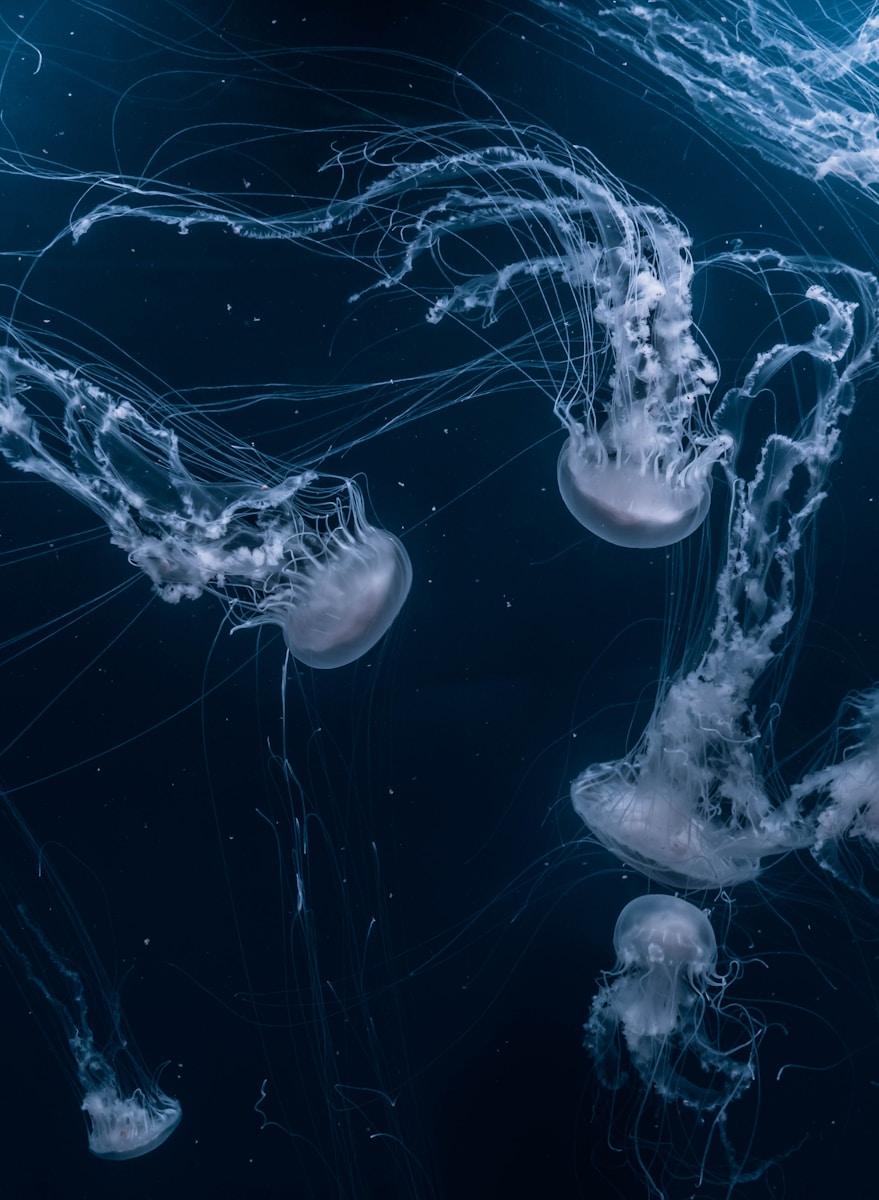Jellyfish are marine invertebrates that belong to the phylum Cnidaria, which also includes similar creatures like corals and sea anemones. They have a simple yet effective body plan and a life cycle that varies among different species. With their gelatinous bodies and stinging tentacles, jellyfish thrive in oceans around the world. They are known for their umbrella-shaped bells and trailing tentacles equipped with stinging cells used for capturing prey.
Where Do Jellyfish Come From?
| Life Stage | Description | Where They Live |
|---|---|---|
| Eggs & Sperm | Jellyfish start as fertilized eggs, a result of sexual reproduction in most species. | Open ocean |
| Planula | A free-floating larva that develops from a fertilized egg. | Open ocean |
| Polyp | A small, sessile (attached) form that resembles a tiny sea anemone. | Seafloor, rocks, etc. |
| Ephyra | A young, immature jellyfish created from the polyp through a process called strobilation. | Open ocean |
| Medusa | The free-swimming, bell-shaped jellyfish form most people recognize. | Open ocean |
Important Notes:
- Two Main Forms: Jellyfish exist in two main forms throughout their life cycle: the sessile polyp and the free-swimming medusa.
- Asexual Reproduction: Polyps can also reproduce asexually by budding off copies of themselves.
- Location: Jellyfish are found worldwide in a variety of marine habitats.

The origins of jellyfish trace back to the earliest times of multicellular organisms in our oceans. These creatures have diversified into approximately 200 known species within the class Scyphozoa and about 20 species within the class Cubozoa. Each species follows a unique life cycle, often starting from a fertilized egg that develops into a planula larva, then into a polyp, and finally maturing into the medusa stage that is most commonly recognized as a jellyfish. Their presence in various marine habitats is not simply due to natural occurrence but also to increasing human interaction, which has affected their distribution and population sizes.
Key Takeaways
- Jellyfish are invertebrates and belong to the phylum Cnidaria alongside corals and sea anemones.
- Species diversity among jellyfish is broad, with their life cycle stages including polyp and medusa forms.
- Human activities impact jellyfish populations, affecting both their ecological roles and interactions with marine environments.
Evolution of Jellyfish
| Time Period / Era | Key Evolutionary Events | Notes |
|---|---|---|
| Precambrian | * Early jellyfish-like forms emerge.* | Fossil evidence is limited |
| Cambrian | * Jellyfish diversify, showing complex body plans.* | Clearer fossil records emerge |
| Ordovician-Silurian | * Mass extinction event impacts jellyfish diversity.* | Some lineages go extinct |
| Devonian-Carboniferous | * Jellyfish rebound with new adaptations.* | Potential for freshwater forms |
| Modern Era | * Jellyfish continue to evolve and occupy diverse marine environments.* | Includes both medusae and polyps |
Important Considerations:
- Soft Bodies: Jellyfish lack hard skeletons, making their fossil record less complete. This challenges our understanding of early evolutionary stages.
- Cnidaria: Jellyfish belong to the phylum Cnidaria, which includes corals and anemones. Their evolutionary origins are shared.
- Medusa vs. Polyp: Modern jellyfish often exhibit a complex life cycle with both a free-swimming medusa stage and a stationary polyp stage. Understanding the evolution of this transition is key.
Biology and Life Cycle
Understanding the biology and life cycle of jellyfish is essential to appreciate these fascinating marine creatures. This section provides insight into their unique anatomical features, intricate reproductive processes, and developmental stages, as well as their place in the evolutionary history of life on Earth.
Anatomical Structure
Jellyfish are invertebrates belonging to the phylum Cnidaria, which also includes species like corals and sea anemones. They are composed of several distinct layers: the outer epidermis, the middle mesoglea (a thick, gelatinous substance), and the inner gastrodermis. These creatures lack a complex brain; instead, they have a simple nervous system that facilitates basic movements and reactions to their environment. The bell is the main body part of a jellyfish from which tentacles extend, containing cnidocytes (special cells) that house nematocysts, which can sting and deliver venom to subdue prey.
Reproductive Processes
Jellyfish can reproduce in two main ways: sexually and asexually. During sexual reproduction, males release sperm into the water that fertilizes female eggs. Asexually, polyps reproduce through a process called budding, where new polyps form alongside the original. Both methods ensure the continuous growth of the jellyfish population.
Growth and Development
The jellyfish life cycle includes several stages: starting with the fertilized eggs, they develop into planula larvae, which settle on a solid surface and become polyps. Polyps then go through a transformation known as strobilation to produce ephyra, a young jellyfish stage, before maturing into the adult medusa form. Species such as Aurelia, Cassiopea, and Chironex exhibit these life cycle stages.
Evolutionary History
Jellyfish are an ancient group of animals with a fossil record dating back to over 500 million years. This makes them one of the oldest multi-organ animals in the evolutionary record. As a member of the Cnidaria phylum, jellyfish share a common lineage with other venomous and luminescent creatures like corals and sea anemones, all characterized by their stinging cells. Over the millennia, jellyfish have evolved into a diverse group, boasting more than 200 species in classes such as Scyphozoa (true jellyfish), Cubozoa (box jellies, known for their potent venom), and Hydrozoa (hydroids), and display a variety of life cycles, from the stationary polyp stage to the free-swimming medusa.
Ecology and Human Interaction
Jellyfish are an important component of marine ecosystems, with interactions that can affect humans in various ways. They inhabit different oceanic habitats, significantly influence food webs, and can both benefit and challenge human activities.
Habitats and Distribution
Jellyfish, often called sea jellies, are found in every ocean, from the shallow coastal waters to the deep sea. Species like deep-sea jellyfish thrive in the darker, more pressured environments of the ocean, while others like the moon jellyfish are common in coastal areas. Ocean currents play a crucial role in their distribution, carrying these gelatinous creatures over great distances. Their presence in diverse habitats makes them key members of the marine community.
Jellyfish and Ecosystems
Jellyfish diet mainly consists of plankton, fish larvae, and small marine animals, placing them as both predators and prey within food webs. As predators, they can influence fish populations by consuming fish larvae and small fish. Some jellyfish have stinging cells called nematocysts, which they use to capture their prey. On the flip side, they serve as food for species like sea turtles and some larger fish. Massive gatherings, known as blooms, can substantially alter the nutrient dynamics in their environments, often as a response to changes in climate or ocean conditions.
Jellyfish and Humans
Interactions between jellyfish and humans are increasing as both parties share coastal areas. Swimmers and divers can experience painful stings from species with powerful venom such as the box jellyfish found in Australia, known for its potentially lethal sting. The irukandji jellyfish, also found in Australia, has a sting that can cause severe pain and is a concern for people in infested waters. Conversely, in places like Japan, some jellyfish are considered a delicacy. The impact of jellyfish on fishing industries can be significant, as they can damage nets, affect fish populations, and reduce local fish catches. Recent research is exploring how jellyfish contribute to marine ecosystems and how they might be managed to reduce negative impacts on human activities.
Frequently Asked Questions
This section addresses common inquiries about jellyfish, their life stages, diversity, diet, environmental interactions, reproduction, and their impact on marine ecosystems.
What is the life cycle of jellyfish?
Jellyfish have a complex life cycle that includes both sexual and asexual phases. They start as fertilized eggs, develop into larval planulae, attach to a surface and transform into polyps, and eventually mature into medusae, the form we recognize as jellyfish.
How do jellyfish species differ from one another?
Jellyfish species vary widely in size, color, and habitat. Some jellyfish like the lion’s mane can grow very large, while others like the Irukandji are quite small. Their stinging abilities also differ, which affects their interaction with humans and other species.
What are the feeding habits of jellyfish?
Jellyfish are typically carnivorous, feeding on plankton, small fish, or even other jellyfish. They use their tentacles to capture prey and transport it to their mouth.
How do environmental conditions affect jellyfish populations?
Environmental factors such as water temperature, salinity, and availability of prey influence jellyfish populations. Conditions like overfishing and climate change can lead to jellyfish blooms, where populations rapidly increase.
What are the reproductive mechanisms of jellyfish?
Jellyfish reproduce in various ways. Some species release eggs and sperm into the water to meet and fertilize, while others can reproduce asexually by budding from polyps. These methods contribute to their ability to quickly populate areas.
How does the presence of jellyfish influence marine ecosystems?
Jellyfish play a significant role in their ecosystems by predating on numerous marine species and competing with fish for food. They can both support and disturb local food chains, depending on their population size and behavior.







